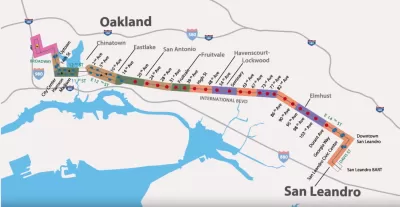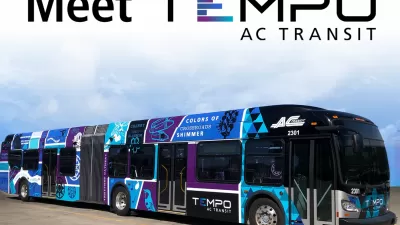A key commercial corridor connecting Oakland and Fremont in the East Bay Area is due for a dramatic transformation in the form of a new Bus Rapid Transit line.

AC Transit will ramp up construction on a $204 million bus rapid transit line along International Boulevard in the East Bay Area, according to an article by Erin Baldassari. The 9.5-mile route will connect the San Leandro BART station to 20th Street and Broadway in Oakland, with buses arriving every seven minutes. The new line also includes "elevated platforms and more comfortable stations, its own travel lane and forward-facing cameras to ticket motorists who block its path," according to Baldassari.
As with most major transit investments, planners also have hopes that the project can be a catalyst for new investments and development along the corridor. And as with most catalytic projects, "some residents, community advocates and business owners fear the same economic development will only accelerate the displacement of Oakland and San Leandro’s most vulnerable residents and small businesses as rents rise throughout the region," according to Baldassari.
The feature-length article then tours several case studies from other cities, like Cleveland and San Francisco, to examine the question of who will benefit from the project.
FULL STORY: Oakland, San Leandro: Some fear ‘transformative’ rapid transit system coming to storied thoroughfare

Trump Administration Could Effectively End Housing Voucher Program
Federal officials are eyeing major cuts to the Section 8 program that helps millions of low-income households pay rent.

Planetizen Federal Action Tracker
A weekly monitor of how Trump’s orders and actions are impacting planners and planning in America.

Ken Jennings Launches Transit Web Series
The Jeopardy champ wants you to ride public transit.

California Invests Additional $5M in Electric School Buses
The state wants to electrify all of its school bus fleets by 2035.

Austin Launches $2M Homelessness Prevention Fund
A new grant program from the city’s Homeless Strategy Office will fund rental assistance and supportive services.

Alabama School Forestry Initiative Brings Trees to Schoolyards
Trees can improve physical and mental health for students and commnity members.
Urban Design for Planners 1: Software Tools
This six-course series explores essential urban design concepts using open source software and equips planners with the tools they need to participate fully in the urban design process.
Planning for Universal Design
Learn the tools for implementing Universal Design in planning regulations.
Ada County Highway District
Clanton & Associates, Inc.
Jessamine County Fiscal Court
Institute for Housing and Urban Development Studies (IHS)
City of Grandview
Harvard GSD Executive Education
Toledo-Lucas County Plan Commissions
Salt Lake City
NYU Wagner Graduate School of Public Service



























